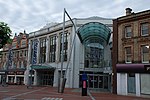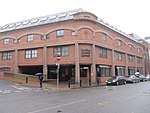St Giles' Church, Reading
Anglo-Catholic church buildings in BerkshireAnglo-Catholic churches in England receiving AEOChurch of England church buildings in BerkshireChurches in Reading, BerkshireGrade II listed buildings in Reading ... and 2 more
Grade II listed churches in BerkshireUse British English from February 2023

St Giles' Church is a Church of England parish church in the town of Reading in the English county of Berkshire.
Excerpt from the Wikipedia article St Giles' Church, Reading (License: CC BY-SA 3.0, Authors, Images).St Giles' Church, Reading
Southampton Street, Reading Coley
Geographical coordinates (GPS) Address External links Nearby Places Show on map
Geographical coordinates (GPS)
| Latitude | Longitude |
|---|---|
| N 51.450983333333 ° | E -0.97040277777778 ° |
Address
St Giles Church
Southampton Street
RG1 2QP Reading, Coley
England, United Kingdom
Open on Google Maps











